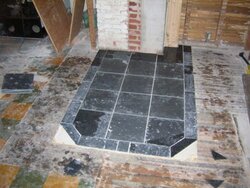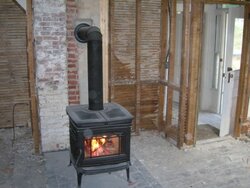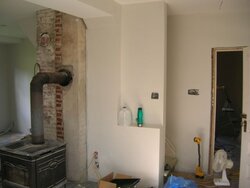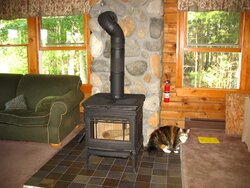Hi folks,
I'll try to make a long story a bit shorter. Renovated house and in order to have heat for Canadian winter (no other heat source at that time) I installed a quick hearth, new Alderlea T5, new lined chimney, had it WETT inspected (Canadian thing) and it works great.
The problem is that I am now going to lay a new oak hardwood floor, and my existing hearth is about 3/8" higher than the new hardwood floor will be. I want it to be flush, for appearance, as well as to avoid a tripping edge. Of course, I could put down 3/8" plywood on top of existing subfloor, before laying new hardwood. Or, I can rip out the hearth, and build a new one 3/8" lower. If I am going to rip it out, and build a new hearth, I am considering pushing the stove back, to allow more walking room in front of the stove. When I installed it, I left about 12" or more behind the stove, as I though I might stud up a new wall in front of the old chimney (see pics). But, we are now going to leave the chimney exposed (non-combustible) or at most use mortar or something similar to add a layer of durock or brick veneer.
If we were to paint the durock, would this then be considered combustible?
I currently have single wall pipe, but can change to double wall.
We are really wondering how close we can go to the old chimney, or the old chimney (covered with durock and painted) so that we can reduce how far the stove and hearth stick out into the room. I would, of course, maintain the 18" ember protection in front of the door, and 8" on the sides. (required in Canada).
The other option is to sell the T5 and buy a T4 ( quite a bit less deep) or Oslo (most of which are wider but less deep). We really love the T5 and how it burns, but I added an air to air heat pump, air hander and ducting this fall, as we would not be there often and needed an economical heat source that would keep the place at a decent temperature to prevent damage. Now, with the heat pump / air handler keeping the house at a decent temperature, the need for a powerful stove, like the T5 has been reduced quite a bit. We will still use the stove, but it will not have to be the main heat source any longer, unless the power goes out!!
House has brand new insulation R20 in walls, more in attic, new vapour barrier. Windows are very old, but have storm windows on for winter, and will eventually replace windows.
As you can see, it is not in an alcove, so lots of air flow on either side. Closest thing will be stools for new kitchen island to the left of stove, but they will be more that 18" away from stove.
Any advice would be appreciated!
I'll try to make a long story a bit shorter. Renovated house and in order to have heat for Canadian winter (no other heat source at that time) I installed a quick hearth, new Alderlea T5, new lined chimney, had it WETT inspected (Canadian thing) and it works great.
The problem is that I am now going to lay a new oak hardwood floor, and my existing hearth is about 3/8" higher than the new hardwood floor will be. I want it to be flush, for appearance, as well as to avoid a tripping edge. Of course, I could put down 3/8" plywood on top of existing subfloor, before laying new hardwood. Or, I can rip out the hearth, and build a new one 3/8" lower. If I am going to rip it out, and build a new hearth, I am considering pushing the stove back, to allow more walking room in front of the stove. When I installed it, I left about 12" or more behind the stove, as I though I might stud up a new wall in front of the old chimney (see pics). But, we are now going to leave the chimney exposed (non-combustible) or at most use mortar or something similar to add a layer of durock or brick veneer.
If we were to paint the durock, would this then be considered combustible?
I currently have single wall pipe, but can change to double wall.
We are really wondering how close we can go to the old chimney, or the old chimney (covered with durock and painted) so that we can reduce how far the stove and hearth stick out into the room. I would, of course, maintain the 18" ember protection in front of the door, and 8" on the sides. (required in Canada).
The other option is to sell the T5 and buy a T4 ( quite a bit less deep) or Oslo (most of which are wider but less deep). We really love the T5 and how it burns, but I added an air to air heat pump, air hander and ducting this fall, as we would not be there often and needed an economical heat source that would keep the place at a decent temperature to prevent damage. Now, with the heat pump / air handler keeping the house at a decent temperature, the need for a powerful stove, like the T5 has been reduced quite a bit. We will still use the stove, but it will not have to be the main heat source any longer, unless the power goes out!!
House has brand new insulation R20 in walls, more in attic, new vapour barrier. Windows are very old, but have storm windows on for winter, and will eventually replace windows.
As you can see, it is not in an alcove, so lots of air flow on either side. Closest thing will be stools for new kitchen island to the left of stove, but they will be more that 18" away from stove.
Any advice would be appreciated!





